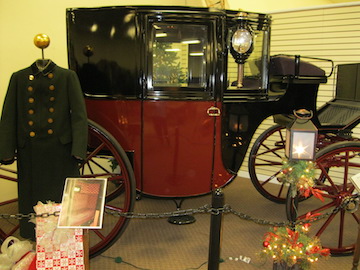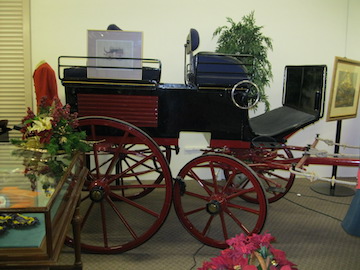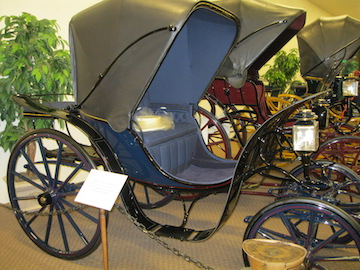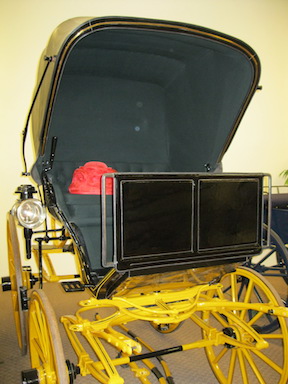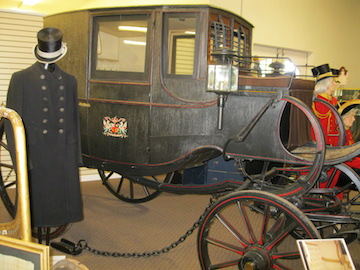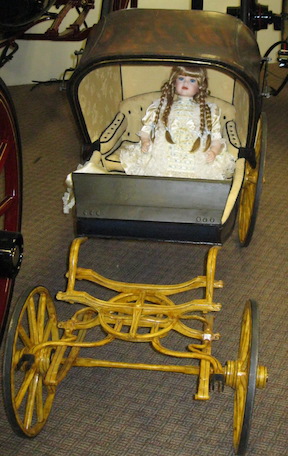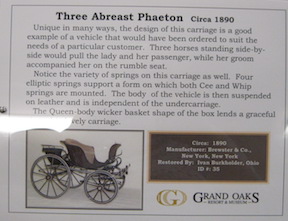Grand Oaks Resort
Weirsdale, Florida
If you think you must travel across the pond to find great historical inspiration, you would be wrong! I’ve been living half the year in Florida for several years now, and just this month discovered the existence of this fabulous museum—only a half-hour drive away!
I travel to the UK every year and have seen some of the best museums and historical sites out there, and I have to rank this one right up with them. The London Transport Museum in Covent Garden is wonderful, but honestly, it doesn’t hold a candle to this one, at least in terms of carriages. The Carriage Museum here has more types of curricles and phaetons and landaus and broughams than I have ever seen in one place. I will definitely be returning here often.
We had a lovely drive around the 340-acre property lined with scenic pastures and oak trees in a carriage drawn by two beautiful Clydesdale horses. Afterwards, we browsed in the gift shop and had lunch in the bistro. There is a luxurious spa on site that people come from all over central Florida to enjoy.
The Grand Oaks Resort is also a major center for equestrian events for spectators and competitors, including polo and dressage. Also offered are first-class boarding and training facilities. (Heather King would love this place, especially the dressage competition in mid-January!)
The Grand Oaks Resort is only an hour drive from Orlando, so if you’re heading this way to take in the Disney and other attractions, consider setting aside a day in the countryside away from the crowds. You won’t be disappointed, and neither will your family.
From MuseumsUSA:
The Grand Oaks Museum is home to one of the world’s largest private collections of carriages and equine artifacts. Step back in time and enjoy the elegance and pageantry of over 160 European and American Carriages, including the elaborate 1850 Armbruster Dress Chariot once owned by Emperor of Austria Franz Joseph, and his wife, Elisabeth. Our Museum uniquely offers a glimpse into the history of the relationship between man and horse and clearly defines the manner in which the horse has helped shape the history of man.

1850 Armbruster Dress Chariot once owned by Emperor of Austria Franz Joseph, and his wife, Elisabeth
Since 1995, The Grand Oaks Museum has opened its doors to the public with an extraordinary display of historical artifacts, while educating visitors with tours, seminars and special programs in a live setting. Take a journey through time into the world of man’s most vital mode of transportation of past centuries. Museum visitors have a rare opportunity to see an English Omnibus, a horse-drawn fire fighting apparatus, a World War I supply wagon, the colorful and ornate Sicilian Caretta and a Dutch Tikker. This Tikker is one of a pair; the other was displayed by Count de Hamptinne in the Hotel Particulier in Ghent, Belgium. And that’s only the beginning of what this Museum has to offer.
The Brougham (1895)
Inspired, if not only designed by Lord Brougham, a statesman of the early 19th century, this lovely vehicle seats 2 passengers facing forward. The low-slung body affords easy entry to this elegant coach luxuriously upholstered for the comfort of a noble gentleman. The interior was often fitted with ashtrays, a clock, and mirrors.
Coachman-driven, the passenger is able to communicate with the driver through a tubular whistle hanging on the interior of the carriage. A system of long and short whistles would inform the driver to turn left, right, stop, or proceed on homeward.
Many Broughams were driven to a strong single horse; but others were set up for a pair, as this one is.
The Clarence (1897)
Like the Brougham, the Clarence is a coachman-driven vehicle, but this larger carriage affords seating for four people, two facing forward, and two riding backward. Fitted with lamps for evening use, it would carry a gentleman and his friends to the opera or a formal dinner party.
This larger vehicle required a pair of horses, and a footman in livery would ride next to the coachman to assist when passengers entered or exited the carriage. He would also “head” the pair if a vehicle waited while the party enjoyed their evening’s activities. Blankets for the horses would be carried in the boot under the coachman’s seat.
The Four-Wheel Dog Cart (1894)
This rare example of a Dog Cart seats six, rather than four, persons. Notice the bench seat between the front and back seats. It would be used for children or small adults agile enough to mount the carriage over the back wheel.
The wheel on the right side of the driver’s seat operates the friction brake on the back wheel of the carriage just below the level of the axle. This wheel design is generally seen on vehicles made in France, but is not favored on British carriages because the driver, or Whip, must shift his position on the seat in order to apply the brake.
This vehicle is set up for a pair of light horses.
George IV Phaeton (1910)
This vehicle was copied from one made for King George IV in 1824, who needed an “easy entry,” more stable vehicle than the highflyer of his youth. As more and more ladies began to take up the art of driving, the carriage design appealed, permitting them to mount the carriage easily despite their long skirts. The high curving dashboard obliterated the horses’ hindquarters from view, saving the lady any embarrassment and protecting fashionable clothing.
When driving classes for ladies were introduced at some American horse shows in the late 1890’s, Brewster and other builders quickly offered George IV Phaetons with their own unique features.
Spider Phaeton (1881)
During the latter part of the nineteenth century, when park driving was at its peak, the Spider Phaeton became the perfect vehicle for showing a spirited single or pair of horses. The body of the vehicle resembles that of a Tilbury Gig, and the carriage almost always has a hood. The groom’s single seat, which is often on branch irons, is connected by an iron framework, giving the appearance of lightness and elegance. The fine lines of this vehicle would flatter a horse’s action, and the lighter weight would allow the animal free flowing movement.
With open futchels, this vehicle can be put to either a pair or a single horse.
Traveling Coach (1800)
Dating from the early 1800’s, this coach was used for long distance travel before the advent of the railroads. A luxurious vehicle, this one seats two persons facing forward with room for two seated backwards. The seats can be made into a bed where two occupants can stretch their legs out under the driver’s seat to offer the possibility of a night’s sleep, as accommodations at inns and post houses were generally poor. The body is moving on Cee-springs and is connected to the perch with leather straps to prevent excessive side sway.
This vehicle has a driver’s seat, but these coaches were often posted to allow more room for luggage and cargo to be carried. Teams of horses would be changed out a stage stops along the way.
The patina on this vehicle simulates the look of a traveling coach which has been on the road for some time. The interior is newly re-upholstered, but the other appointments are original to the carriage. The shutters can be used to shade the occupants from both daylight and inclement weather.
Goat Caleche
Another vehicle intended to be put to a goat which would have been led by a liveried groom, this beautiful caleche follows the same curving lines as its full-sized counterpart. The upholstery is light and rich in appearance, and the folding hood is lined in the same material.
A nanny might take her charges out for an afternoon stroll with this vehicle.
Hansom Cab (1895)
The Hansom Cab is named for its early designer, Mr. J.A. Hansom, but cabs used for public transport in the latter half of the 19th century bear little resemblance to earlier models.
The driver sits at the rear of the box, high above for a better view of the city. An unusually strong and quiet cab horse was required to pull the vehicle, as the shaft weight was extremely heavy. At rest, the driver would release the “spoke” under the carriage and ask the horse to back a few steps. This would help to pull some of the carriage weight off the animal’s back and save him for further work.
The public Hansom was thought to be an improper vehicle for a lady to use by herself. But many privately owned, immaculately appointed Hansoms, like this beautiful example, were used instead of a Brougham or a Victoria for simple trips around town.
Char-de-côté
Three Abreast Phaeton (1890)
More photos on my Pinterest board.





